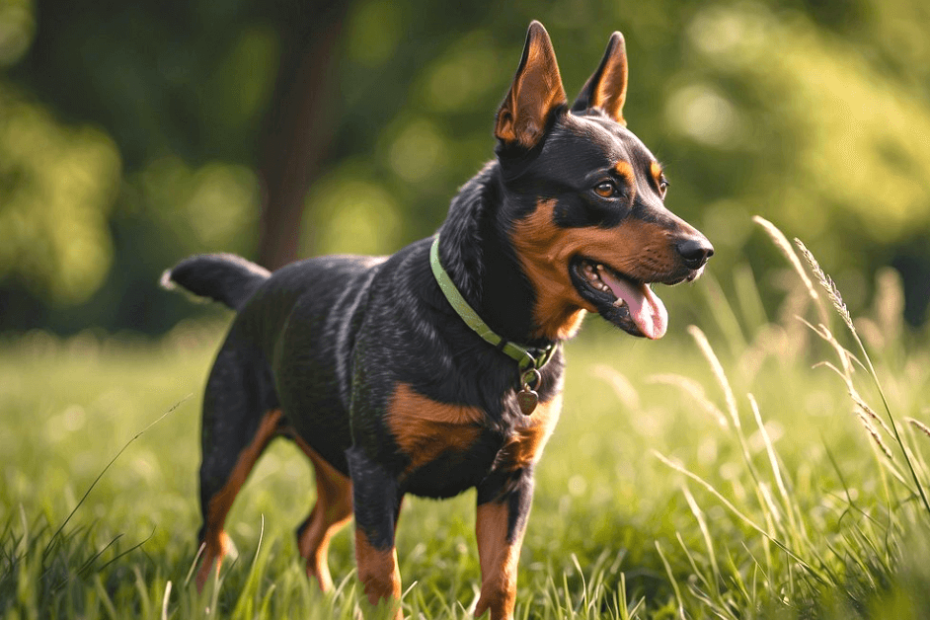With their recent recognition by the American Kennel Club, Lancashire Heelers are trotting proudly into the spotlight and capturing the admiration of a growing number of fans.
The Lancashire Heeler, a dynamic and spirited companion, has a captivating history and a personality that’s bound to steal the hearts of dog enthusiasts.
Bred originally in England for herding and driving cattle to market, this breed carries the hardworking spirit of a heeler with the zest and intelligence of a terrier.
Their distinctive black and tan or liver and tan coat is not only striking, but also weather-resistant, an attribute that speaks to their resilience as working dogs.

Breed Origin
The Lancashire Heeler breed’s development is wrapped in the unique history and geography of the British Isles, with direct links to Viking influence and native British herding dogs.
Historical Development
The Lancashire Heeler displays a rich heritage that is believed to involve an intricate mix of breeds throughout history.
Specifically, they are said to have genetic ties to the Welsh Corgi, a breed utilized historically to drive livestock.
These dogs were brought to the northwest of England from Wales, contributing to the development of the Heeler.
Another significant influence comes from dogs brought by the Vikings, which were similar to the contemporary Swedish Vallhund and may also be part of the Lancashire Heeler’s lineage.

Geographical Origins
The breed, as its name suggests, hails from the county of Lancashire in the United Kingdom.
The exact origins of the breed are not definitively known, but it is agreed that the Lancashire Heeler was bred for practical purposes, such as herding and driving cattle.
Their historical presence is identified within the geographic area of northwest England, where they were particularly valued for their agility, compact size, and tenacity, traits necessary for managing cattle over diverse terrains.
The American Kennel Club introduces new dog breed: Meet the Lancashire Heeler further discusses the breed’s recent recognition and its distinct qualities.
Physical Characteristics

The Lancashire Heeler is a small but robust dog breed known for its agility and vivacity, presenting a well-proportioned and sturdy appearance.
Coat and Color
The coat of the Lancashire Heeler is short, dense, and weather-resistant, with a slightly harsher outer coat and a soft undercoat.
They commonly display a striking black or liver color with tan markings, which accentuate their expressive faces and underline their alert nature.
Size and Build
Adult Lancashire Heelers typically stand at 10 to 12 inches in height at the withers and weigh between 13 to 15 pounds.
Their build is powerful yet compact, reflecting their herding dog origins with strong limbs and an overall sturdy constitution.
Distinctive Features
These dogs often ‘smile’ by pulling their lips back in a human-like fashion, contributing to their endearing charm.
Another notable characteristic is their alert, pointed ears which enhance their lively expressions, drawing attention to their watchful and spirited disposition.
Personality Traits

The Lancashire Heeler is known for its dynamic personality, characterized by an intelligent and affectionate nature.
They exhibit a diverse range of behaviors that reflect their herding legacy and are adaptable to various family environments.
Temperament
Lancashire Heelers are intelligent and alert dogs that carry a friendly demeanor.
Their versatility shines through their ability to switch from a playful companion to a determined working dog when needed.
They are known to be affectionate with their families, showing a loyalty that makes them excellent household pets.
Behavioral Tendencies
- Energetic and Playful: Lancashire Heelers have a high-energy level that demands regular exercise.
- Social Interaction: They form strong bonds and enjoy participating in family activities. These dogs tend to be good with children when properly socialized from a young age.
- Herding Instinct: Their natural herding instinct can manifest as nipping at people’s heels, but this can be managed with proper training and socialization.
Health and Care
When considering the health and care of the Lancashire Heeler, potential owners should be aware of a few breed-specific health concerns, understand their unique dietary needs, and adhere to a regular grooming routine to ensure their pet lives a happy, healthy life.
Common Health Issues
The Lancashire Heeler is generally a hardy breed but can be predisposed to certain health conditions.
Notably, they are known to sometimes face Primary Lens Luxation (PLL) and Collie Eye Anomaly (CEA), both of which can affect their vision.
These dogs may also be at risk for Patellar Luxation, a knee condition that can impact their mobility.
Monitoring for signs of joint issues and maintaining routine veterinary check-ups can help catch and manage these concerns early on.

Dietary Needs
Regarding their diet, Lancashire Heelers require well-balanced meals that are appropriate for their size and energy level.
An ideal meal plan should include a mix of proteins, carbohydrates, and essential fats to support their medium to high energy needs.
Specific dietary considerations may vary based on individual health needs, so consulting with a veterinarian can ensure they receive the right nutrients.
Grooming and Maintenance
Lancashire Heelers have a short, weather-resistant coat which makes their grooming needs relatively straightforward.
They benefit from regular brushing to minimize shedding and to keep their coat in good condition.
Occasional baths are sufficient to keep them clean, but care should be taken not to over-bathe as it can strip natural oils from their coat.
Additionally, routine ear checks, nail trims, and dental care will contribute to their overall well-being.
Training and Activities
The Lancashire Heeler thrives with proper training and ample exercise.
This section uncovers key training strategies, outlines the exercise demands, and suggests enjoyable activities tailored to keep these bright dogs both mentally and physically engaged.

Training Essentials
Lancashire Heelers are intelligent and can be quite receptive to training when it starts early.
They sometimes exhibit a stubborn streak, so consistency is crucial.
Positive reinforcement techniques work best, rewarding good behavior with treats or praise to encourage cooperation.
Training should be a mix of firmness and kindness, ensuring that the dog understands who’s in charge without feeling overwhelmed.
Exercise Requirements
A highly energetic breed, Lancashire Heelers require regular exercise to maintain their mental and physical health.
Owners should aim for at least one good walk per day combined with play sessions.
Their strong herding instincts often lead to a natural enjoyment of games that involve running and chasing.
Suitable Activities
Designed for herding and farm work, these dogs excel in activities that challenge both their mind and their agility.
Treibball is an excellent choice; it taps into their instinct to herd without the need for livestock.
Interactive games like fetch, frisbee, and obstacle courses satisfy their need for physical activity and mental stimulation.
They often do well in dog sports such as agility and flyball, given their quick reflexes and love for running.
Breed Recognition and Clubs

The Lancashire Heeler has garnered official recognition and has a dedicated following with established clubs that celebrate this spirited breed.
Kennel Club Classifications
In the world of dog breeds, official recognition serves as a hallmark of a breed’s stability and standards.
The Lancashire Heeler, a breed known for its agility and herding prowess, achieved full recognition from The Kennel Club (United Kingdom) in 1981.
Further cementing its status in the canine community, the breed was admitted into the American Kennel Club’s Foundation Stock Service in 2001, and as of recent updates, has moved forward with full recognition by the AKC.
Breed Clubs and Societies
Breed clubs and societies play a crucial role in the preservation and promotion of dog breeds.
For the Lancashire Heeler, the United States Lancashire Heeler Club is a prime example, advocating for the breed and providing resources to owners and enthusiasts.
Across the pond, the Lancashire Heeler enjoys the support from its native land through the United Kingdom’s own breed clubs, which have long celebrated the breed’s distinct qualities.




